
Tiger beetles are a family of beetles, Cicindelidae, known for their aggressive predatory habits and running speed. The fastest known species of tiger beetle, Rivacindela hudsoni, can run at a speed of 9 km/h, or about 125 body lengths per second. As of 2005, about 2,600 species and subspecies were known, with the richest diversity in the Oriental (Indo-Malayan) region, followed by the Neotropics. While historically treated as a subfamily of ground beetles (Carabidae) under the name Cicindelinae, several studies since 2020 indicated that they should be treated as a family, the Cicindelidae, which are a sister group to Carabidae within the Adephaga.
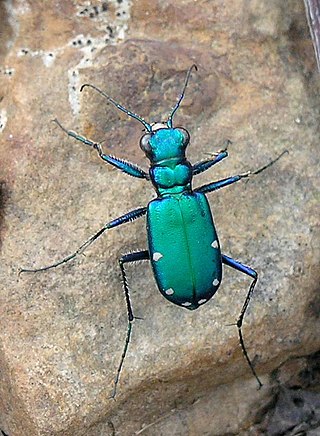
The six-spotted tiger beetle, also known as the six-spotted green tiger beetle, is a common North American species of tiger beetle in the Cicindelinae subfamily. It is common in many areas of the states, and is well known. It is recognized for its bright green color and its flight pattern. The beetle is largely harmless to humans and may live as long as three years.

Cicindela, commonly known as common tiger beetles, are generally brightly colored and metallic beetles, often with some sort of patterning of ivory or cream-colored markings. They are most abundant and diverse in habitats very often near bodies of water with sandy or occasionally clay soils; they can be found along rivers, sea and lake shores, sand dunes, around dry lakebeds, on clay banks, or woodland paths.
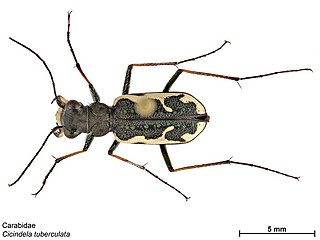
Neocicindela tuberculata is a species of tiger beetle in the family Cicindelidae, endemic to New Zealand. Its common names include common tiger beetle, moeone, and papapa, and in its laval stage penny doctor, butcher boy, kapuku, kui, kurikuri, moeone, and muremure. Neocicindela tuberculata was the first carabid beetle described from New Zealand. The species can run as fast as 5 miles per hour and are considered to be the fastest running beetles. Adult species prefer clay banks in summer and are good predators when in comes to insects.
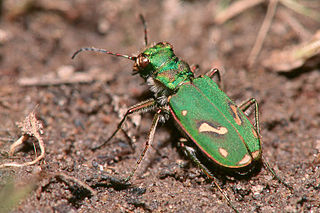
Cicindela ohlone, the Ohlone tiger beetle, is endemic to California. It was discovered in 1987 and named and described in 1993. C. ohlone is most closely related to Cicindela purpurea.
Cicindela columbica is a species of beetle in the tiger beetle family, Cicindelidae, known commonly as the Columbia River tiger beetle. It is endemic to Idaho in the United States.
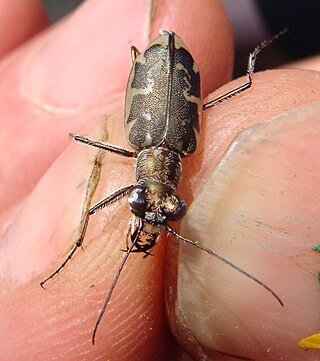
The Puritan tiger beetle is a tiger beetle found in North America. Puritan tiger beetles are found in sandy beaches and rocky cliffs along rivers in Massachusetts, Maryland, and Connecticut. Little is known about this species due to its small geographic range and quickly disappearing populations.

Cicindela hirticollis is a species of tiger beetle that is commonly found in sand bars and sandy beaches of North America. It is medium-sized, is about 2–14 mm (0.08–0.55 in) long, and is active in the summer. The dorsal surfaces of the head, prothorax, and elytra are dark brown. The elytral markings are very light-colored cream or white. The species' common names are hairy-necked tiger beetle and moustached tiger beetle. Its population is in decline.
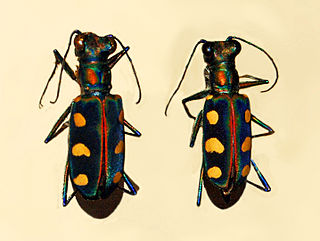
Cicindela aurulenta, common name blue-spotted or golden-spotted tiger beetle, is a beetle of the family Cicindelidae.
Cicindela denikei, Laurentian tiger beetle is a species of tiger beetle in the Cicindelinae subfamily that can be found in Minnesota, Manitoba, and Ontario. The species have green coloured elytron and is 13–15 millimetres (0.51–0.59 in) long. It can be found in gravel and sand as well as coniferous forests where it preys on other insect species. When it comes to hunting, adults are either wait for their prey in an ambush or chase it. It larvae usually digs burrows in which they wait for their victim to come by. Once an unsuspected arthropod is in sight, it opens it jaws and eats it.

Cicindela patruela, the northern barrens tiger beetle, is a species of tiger beetle found in eastern North America. Due to their specific habitat requirements as well as human involvement, populations of this species have declined significantly in several regions, including most of New England, Ontario, and Quebec.

Cicindela arenicola is a species of tiger beetle in the genus Cicindela. It was first described in 1967. Its common names include St. Anthony Dune tiger beetle and Idaho Dunes tiger beetle.
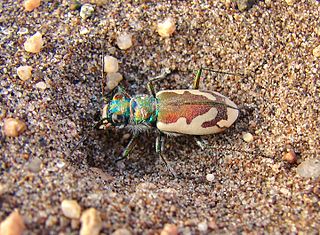
Cicindela theatina, commonly known as the Great Sand Dunes tiger beetle, is a predatory beetle found in sparsely vegetated sandy habitats. The species' range encompasses only about 290 square kilometres (110 sq mi) in the Great Sand Dunes National Park in Colorado. Despite its small range, the species is relatively secure because its entire habitat is within a protected national park.
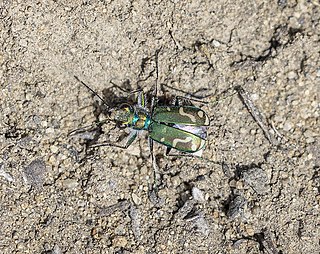
Cicindela decemnotata, the badlands tiger beetle, is a species of flashy tiger beetle in the family Cicindelidae. It is found in North America.

Habroscelimorpha dorsalis, commonly known as the eastern beach tiger beetle, is a species of flashy tiger beetle in the family Cicindelidae. It is found in Central America and North America.
Cicindela limbata, the sandy tiger beetle, is a species of flashy tiger beetle in the family Cicindelidae. It is found in North America.
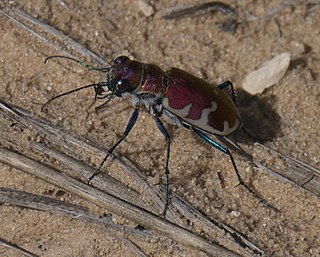
Cicindela formosa, the big sand tiger beetle, is a species of flashy tiger beetle in the family Cicindelidae. It is found in North America.

Habroscelimorpha dorsalis dorsalis, commonly known as the northeastern beach tiger beetle, is the largest subspecies of eastern beach tiger beetle. In 2012, Cicindela dorsalis dorsalis was reclassified under the name Habroscelimorpha dorsalis dorsalis, but the names are used synonymously in recently published literature. Fitting to its common name, the northeastern beach tiger beetle dwells along the U.S. northeast coast in small sand burrows. The beetle is diurnal and can be spotted by its light tan coloring with dark lines and green hues on its thorax and head.

Rivacindela hudsoni is an Australian species of the family Cicindelinae or "tiger beetle" and is the fastest-running known insect. The genus Rivacindela is contentiously treated as a subgenus of the broader Cicindela and are typically found in saline habitats such as dry salt lakes and salt streams and are flightless. The species was discovered in South Australia and described in 1997, with an adult form of approximately 20–21mm in length and a running speed of 2.49 m/s, or 120 body lengths per second.
Cicindela senilis, or the senile tiger beetle is a species of tiger beetle found in western California. It lives in tidal mud flats and both coastal and inland salt marshes.

















